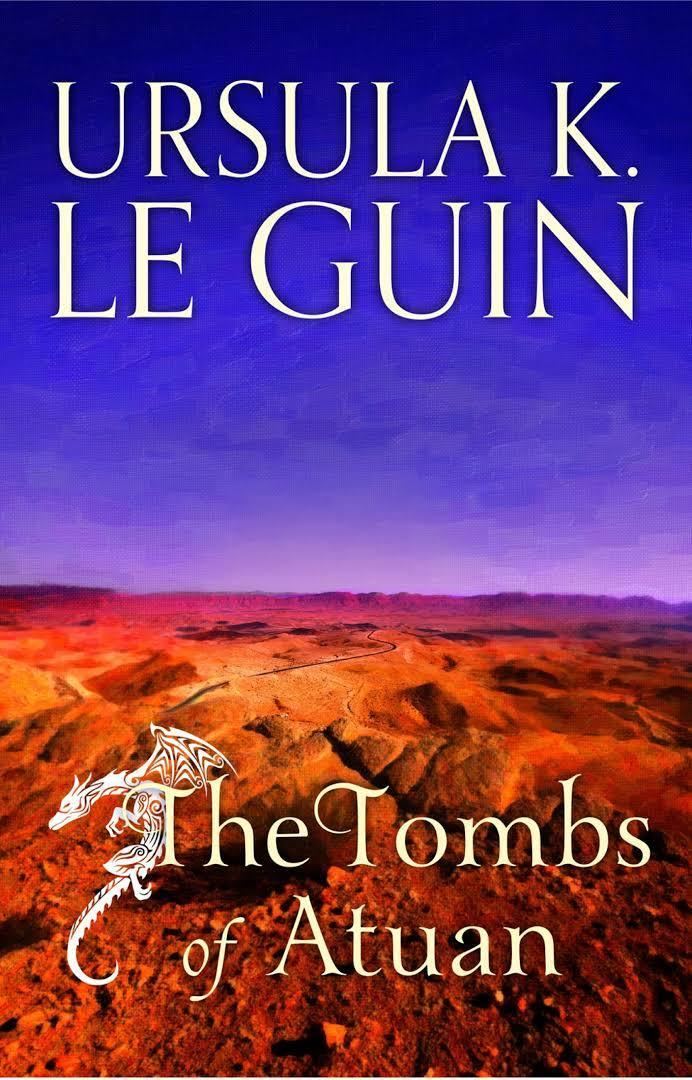8 /10 1 Votes8
3.9/5 Barnes & Noble Country United States Publication date 1971 | 4.1/5 Goodreads Cover artist Gail Garraty Language English Originally published December 1970 Page count 163 (first edition) | |||||||||||||||||||||||||||||||||
 | ||||||||||||||||||||||||||||||||||
Similar Ursula K Le Guin books, Earthsea books, Fantasy books | ||||||||||||||||||||||||||||||||||
The Tombs of Atuan is a young adult fantasy novel by the American author Ursula K. Le Guin, first published in the Winter 1970 issue of Worlds of Fantasy and published as a book by Atheneum in 1971. It is the second book in the series commonly called the Earthsea Cycle. The events of The Tombs of Atuan continue the story of Ged, a wizard introduced in the previous novel, A Wizard of Earthsea. The Tombs of Atuan was a Newbery Honor Book in 1972.
Contents
Like A Wizard of Earthsea, The Tombs of Atuan is a coming-of-age story. The story is told from the perspective of Tenar (also called Arha), a young priestess who traps Ged in a labyrinth. Tenar is often considered a female counterpart to Ged, and the two characters can be said to represent "male" and "female" comings of age. Tenar would be the subject of the later book Tehanu.
Owl reviews the tombs of atuan spoilers
Plot summary
The story centers on a Kargish child, taken from her family and dedicated as the high priestess in the service of the "Nameless Ones" on the island of Atuan. Her name is Tenar, but she is renamed Arha, "the eaten one", when formally consecrated to the gods' service at age six, as all the high priestesses are considered reincarnations of the first.
Arha's youth is a contrast between childish escapades and dark rituals. Her only friends are the eunuch Manan and Penthe, a young priestess her own age. Gradually she comes to accept her lonely role, and to feel at home in the unlit underground labyrinth, the eponymous Tombs, where the malevolent, powerful Nameless Ones dwell and where prisoners are sent to be executed. As Arch-Priestess, Arha is made complicit in the evil system and orders prisoners who are sent by the God-Emperor to be killed slowly by starvation – a cruel act which is to haunt her in later life. As she becomes aware of the political conflicts between the older priestesses Thar and Kossil, the Tombs become a refuge to her, as she is the only one permitted to move freely through the labyrinth beneath them. After Thar dies, Arha becomes increasingly isolated: although stern, Thar had been fair to her. Now only Arha and Kossil remain; Kossil despises Arha and sees the Nameless Ones' cult as a threat to her power.
The numbing routine of Arha's world is disrupted by the arrival of Ged (the protagonist of A Wizard of Earthsea). He has come to the Tombs looking for the long-lost half of the Ring of Erreth-Akbe, a magical talisman, broken centuries before, necessary for peace in Earthsea. (The other half had come into his possession by chance, and a dragon had informed him of its true nature). Arha finds him in the labyrinth, and traps him underground to punish what she sees as sacrilege. She goes back and forth in her mind as to whether she should kill him. Yet in her loneliness, she is drawn to him and listens as he tells her of the outside world. Arha spares Ged's life and keeps him prisoner in the tombs, bringing him food and water. However, the priestess Kossil learns of Ged's existence. Arha promises that Ged will be sacrificed to the Nameless Ones, but realizes that she cannot go through with it. She instructs Manan to dig a false grave underground, while she herself takes Ged to hide in the treasury of the Tombs, where only she is permitted to go.
By now Arha's relations with Kossil have deteriorated irrevocably, to the point of a public falling out in front of the subordinate priestesses. Kossil tells her openly to her face that nobody believes in the Nameless Ones anymore, and that Arha is only a powerless figurehead. The real power lies with her, Kossil, as priestess of the Godking. In response Arha curses her in the name of the Nameless Ones. After her anger has cooled, Arha realizes that Kossil will now be determined to kill her, and that nobody can stop her. She heads underground to the labyrinth, and is horrified to find Kossil uncovering the false grave, and using a light to desecrate the tombs. She heads for the treasury where Ged is kept prisoner, confesses everything to him.
In the meantime, Ged has discovered what he came to find – the other half of Erreth-Akbe's ring. He asks Arha to abandon her role as priestess and escape with him from the tombs. Arha is eventually won over by Ged's kindness, realizing that the Nameless Ones demand her service but give nothing and create nothing in return. Ged must continually expend his strength hiding himself from the Nameless Ones, as they would kill him if they detected his presence. Realizing that she has no future in the Tombs, Arha renounces her role as priestess and reverts to calling herself by her original name, Tenar. She helps Ged escape from the Tombs and they fall in upon themselves as Tenar and Ged leave. At the last moment, before leaving the island on Ged's boat, the Nameless Ones for a moment reassert their control over Tenar and she contemplates killing Ged, but by speaking calmly and unfearingly he breaks the last of the evil influence.
Ged brings her with him back to Havnor where they are received in triumph, and the reunited ring of Erreth-akbe ushers in a new era of peace to Earthsea.
